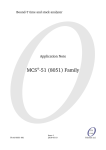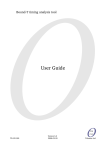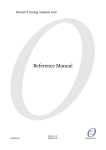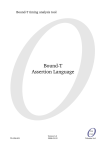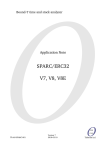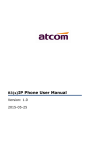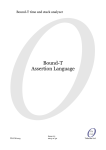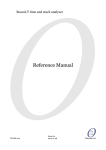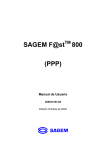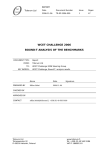Download find_marks User Manual - Bound
Transcript
BoundT timing analysis tool find_marks User Manual TRUM004 Version 1 20090404 Tid rum Tidorum Ltd. Tid rum Tidorum Ltd www.tidorum.fi Tiirasaarentie 32 FI00200 Helsinki Finland This document was written and is currently maintained at Tidorum Ltd by Niklas Holsti. Copyright 2009 Tidorum Ltd. This document can be copied and distributed freely, in any format or medium, provided that it is kept entire, with no deletions, insertions or changes, and that this copyright notice is included, prominently displayed, and made applicable to all copies. Document reference: Document issue: Document issue date: find_marks version: Last change included: Web location: TRUM004 Version 1 20090404 1 BTCH0169 http://www.boundt.com/findmarksmanual.pdf Trademarks: BoundT is a trademark of Tidorum Ltd. Credits: This document was created with the free OpenOffice.org software, http://www.openoffice.org. We are grateful to Ada Core Technology (ACT) and the Free Software Foundation (FSF) for the GNAT Ada compiler that we use to compile find_marks. Preface The information in this document is believed to be complete and accurate when the document is issued. However, Tidorum Ltd. reserves the right to make future changes in the technical specifications of the product find_marks described here. For the most recent version of this document, please refer to the website http://www.tidorum.fi/. As find_marks is distributed under the GNU Public Licence, users may also change the program. This document describes the program as Tidorum provides it. If you have comments or questions on this document or the product, they are welcome via electronic mail to the address info @tidorum.fi or via telephone, telefax, or ordinary mail to the address given below. Please note that our office is located in the timezone GMT + 2 hours, and office hours are 9:00 16:00 local time. In summer daylight savings time makes the local time equal GMT + 3 hours. Cordially, Tidorum Ltd. Telephone: Fax: Web: Email: +358 (0) 40 563 9186 +358 (0) 42 563 9186 http://www.tidorum.fi/ [email protected] Mail: Tiirasaarentie 32 FI00200 Helsinki Finland iii Contents 1 INTRODUCTION 1.1 1.2 2 Scope and purpose..........................................................................................1 Overview of this document..............................................................................3 USING FIND_MARKS 2.1 2.2 2.3 3 4 5 14 Introduction...................................................................................................14 Format of mark definitions.............................................................................14 How find_marks uses the format...................................................................15 ARCHITECTURE OF FIND_MARKS 5.1 5.2 5.3 9 Supported programming languages................................................................9 Core text form.................................................................................................9 Marks in Ada code.........................................................................................11 Marks in C code.............................................................................................11 Marks with selectable prefix and suffix strings..............................................12 MARK DEFINITION FILE FORMAT 4.1 4.2 4.3 4 The find_marks command line.........................................................................4 Command-line options.....................................................................................4 Error and warning messages...........................................................................6 WRITING MARKS IN SOURCE CODE 3.1 3.2 3.3 3.4 3.5 1 17 Modules.........................................................................................................17 Classes and types..........................................................................................17 Adding a new mark format............................................................................18 Tables Table Table Table Table Table Table Table Table Table 1: 2: 3: 4: 5: 6: 7: 8: 9: General options.......................................................................................................5 Options for choosing input language.......................................................................5 Language from file-name suffix...............................................................................6 Warning and error messages...................................................................................6 Supported languages and mark formats.................................................................9 Mark definition fields.............................................................................................14 Keywords for the Part field.....................................................................................15 Keywords for the Relation field..............................................................................15 Modules in find_marks...........................................................................................17 Figures Figure 1: Inputs, outputs, and context of find_marks............................................................3 iv 1 INTRODUCTION 1.1 Scope and purpose The BoundT tool This document is the User Manual for the program called find_marks, a program provided by Tidorum Ltd under the GNU Public Licence (GPL). The find_marks program is an auxiliary program that is used to prepare input for the BoundT program, also from Tidorum. BoundT is a tool for developing realtime software – computer programs that must run fast enough, without fail. The main function of BoundT is to compute an upper bound on the worstcase execution time of a program or subprogram. BoundT does that by static analysis of the machinecode form of the program. For more information about BoundT please refer to the User Guide, at http://www.boundt.com/userguide.pdf, or the Reference Manual, at http://www.boundt.com/refmanual.pdf. Assertions, and the need to identify program parts The task BoundT tries to solve is generally impossible to automate fully. Finding out how quickly the target program will finish is harder than finding out if it will ever finish – the famously unsolvable “halting problem”. For difficult target programs the user can control and support BoundT's automatic analysis by writing assertions. An assertion is a statement about the target program that the user knows to be true and that bounds some crucial aspect of the program's behaviour, for example the maximum number of a times a certain loop is repeated. Assertions are written in text files and expressed in the BoundT assertion language as described in the BoundT Assertion Language manual, http://www.boundt.com/assertion lang.pdf. Each assertion must somehow identify the part or parts of the target program to which the assertion applies. For example, an assertion on the maximum number of repetitions of a loop must identify which loop is meant. The BoundT assertion language provides several ways to identify program parts. One of these ways is to use the sourcecode position of the part, which concretely means to identify the part by the sourceline number and sourcefile name of some sourcecode line in or close to this part. Consider, for example, the following C function add_up, where line numbers are shown on the left and only the start of the function is shown in detail: 33 34 35 36 37 38 39 40 41 ... 67 68 ... int add_up (int A[], int n) { int sum = 0, i; for (i = 0; i < n; i++) { sum += A[i]; A[i] = 0; } ... } ... The function contains a loop, for (i ...), for which BoundT may not be able to find repetition bounds automatically, by analysis, which means that the user must supply the bounds by an asssertion. find_marks user manual Introduction 1 If the user chooses (or is forced) to identify the loop by its sourcecode position, the assertion could be expressed as follows in the BoundT assertion language: subprogram “add_up” loop on line 37 repeats 21 times; end loop; end “add_up”; The compiler and linker that generate the target program from the source code also create a mapping between sourcecode positions and machinecode addresses. This mapping is part of the debugging information in the executable target program (for example, an ELF file) and is accessible to BoundT. When BoundT analyses the subprogram add_up it creates the machine code controlflow graph, which shows (among other things) the machinecode addresses of the instructions in the loop. If the compilergenerated sourcetoobject mapping is good enough, BoundT can connect the machinecode address of the loop to “line 37” in the source code, and thus understand that this assertion should be applied to this loop. Instability of line numbers, and countering it by offsets or marks So far so good, but what happens if the target program is modified by adding or removing some lines of code before the function add_up, in the same sourcecode file? Then all line numbers in add_up will change, so the line number in the assertion must also be changed. But updating assertion files in this way is cumbersome and errorprone. The BoundT assertion language offers two ways to solve this problem. One way is to use line number offsets instead of absolute line numbers; this is explained in the Assertion Language manual and will not be discussed further here. The other way is to use marks embedded in the source code, which is where find_marks is useful and is our focus in this manual. Example of sourcecode marks Consider the source code of add_up with one additional comment – a mark: 33 34 35 36 37 38 39 40 41 42 ... 68 69 ... int add_up (int A[], int n) { int sum = 0, i; /**Mark line below “summer” */ for (i = 0; i < n; i++) { sum += A[i]; A[i] = 0; } ... } ... With the help of the find_marks program BoundT can now know that the markername “summer” means line 38 of this sourcecode file. The loopbound assertion can therefore be written using this marker name instead of an actual line number: subprogram “add_up” loop marked “summer” repeats 21 times; end loop; end “add_up”; This assertion is robust against changes in the target program, as long as the “summer” mark remains on the line before the start of the loop. 2 Introduction find_marks user manual So what does find_marks do? The find_marks program reads sourcecode files, finds the mark lines, and outputs a table that shows the sourcecode position (file name, line number) of each mark. The table is stored in a text file, called a markdefinition file, that BoundT reads together with the assertion files. Figure 1 below shows the inputs and outputs of find_mark and BoundT. The area outlined by the dashed rectangle is the focus of this manual. Compiler & linker Source code Libraries Kernel Find marks Machine code program Sourcecode mark positions User assertions on loop bounds, variable values, call counts, etc. BoundT Analysis results Figure 1: Inputs, outputs, and context of find_marks 1.2 Overview of this document This document is organised into chapters as follows: • Chapter 2 shows how find_marks is used, that is, how to write a find_marks command and what the commandline options and arguments mean. This chapter also lists all warning messages and error messages from find_marks, with explanations and advice on solving the problems. • Chapter 3 explains how to add marks to sourcecode files in any of the formats and programming languages that find_marks currently supports. • Chapter 4 defines the format of the markdefinition files that find_marks produces and BoundT consumes. This chapter is useful if you want to write a new markfinder program from scratch: it specifies the format of the output that your program should produce. • Chapter 5 describes the internal architecture of find_marks to help you extend or modify the program. The chapter ends with advice on how to add a new programming language (a new mark format) to find_marks. find_marks user manual Introduction 3 2 USING FIND_MARKS 2.1 The find_marks command line The find_marks program is executed from the command line and given a list of arguments that can contain any mixture of input (sourcecode) file names and options: find_marks argument1 argument2 ... The arguments that start with a hyphen '–' are interpreted as options. The other arguments are interpreted as the names of sourcecode files to be scanned for marks. The order of the arguments is meaningful: options apply to all following input files until overridden by new options. For example, the following command scans the file libs.c under the default options and the file aux.txt under the option c: find_marks libs.c c aux.txt Storing the mark definitions in a file When find_marks finds a mark in an input file it writes the mark definition on the standard output channel. Thus, use the '>' redirection operator to store the output in a file, as in: find_marks libs.c c aux.txt >libs.marks Combining the results of several find_marks runs Mark definition files are “flat” text files with one mark definition per line and no headers or trailers. Thus you can use simple file concatenation to combine mark definitions from several executions of find_marks. For example, you can use the appending redirection operator '>>' if your command shell supports it: find_marks libs.c >libs.marks find_marks c aux.txt >>libs.marks The file libs.marks then contains both the marks from libs.c and those from aux.txt. Errors and warnings Errors and warnings from find_marks appear on the standard error channel. See Table 4 below. 2.2 Command-line options Commandline options for find_marks fall into two groups: firstly, options significant to the general operation of find_marks and listed in Table 1 below; and secondly, options that define the type of sourcecode in the following input files, which defines the format of the marks in those files. The options in the second group are listed in Table 2 below. All options are casesensitive: the option ada cannot be written ADA. 4 Commandline options find_marks user manual Table 1: General options Option Meaning and default value At present there are no general options Table 2: Options for choosing input language Option Meaning and default value ada Function Tells find_marks that the next input files contain Ada source code, until the next languagechoosing option is found. See section 3.3 for the Ada mark format. auto c Default See auto. Function Makes find_marks choose the source language for the next input files based on the suffix (“file type”) of the file name. Default This is the default. The auto option is useful to override a language chosen by earlier options. Function Tells find_marks that the next input files contain C source code, until the next languagechoosing option is found. See section 3.4 for the C mark format. com=commentprefix pre=markprefix Default See auto. Function Tells find_marks that the next input files, until the next languagechoosing option is found, contain source code in some unspecified language but with marks defined by the given commentprefix and markprefix strings and an optional mark suffix string (see the suf option). See section 3.5 for this mark format. suf=marksuffix Default See auto. Function Augments the com and pre options by specifying a mark suffix string. Note that this string is not a filename suffix. See section 3.5 for this mark format. Default By default the mark suffix string is null, which means that mark lines have no ending suffix – the list of marker names is terminated only by the end of the mark line. The auto option The choice of an input language, for example with the option c , is in effect for all following input files on the command line, until overridden by another choice. Take, for example, this command: find_marks libs.c ada aux.txt main.c >marks.txt find_marks user manual Commandline options 5 This command scans the file libs.c for markers in the C format, chosen by the filename suffix (.c). The file aux.txt is scanned for markers in the Ada format, chosen by the preceding option ada. However, this option is in effect also for the next file main.c , which is perhaps not intended. The command can be altered in several ways to use the C language format for marks.c : • Move the filename to an argument position that is not controlled by the ada option: find_marks libs.c main.c ada aux.txt >marks.txt • Add an option to choose the right language before the filename: find_marks libs.c ada aux.txt c main.c >marks.txt • Use the option auto to override the earlier option ada and restore the default method for choosing the language based on the filename suffix,: find_marks libs.c ada aux.txt auto main.c >marks.txt Table 3 below shows the mapping from filename suffix to assumed programming language and mark format. Note that suffixes are compared in a caseinsensitive way. For example, the suffix ADB is equivalent to adb . Table 3: Language from file-name suffix 2.3 Filename suffix Language adb Ada c C Error and warning messages Problems with the commandline options or the marks written in the input files can make find_marks issue a warning or error message on the standard error channel. The following table lists all these messages in alphabetical order, ignoring punctuation characters and letter case. For each message, the table explains the problem in more detail and may suggest possible reasons for the problem and specific solutions. Variable parts of the messages are shown in italic style and are not included in the alphabetical ordering. Table 4: Warning and error messages Message Meaning and remedy file:Cannot find this file. file:Cannot open this file. 6 Errors and warnings Reasons There seems to be no real file with this file name. Action Correct the command line (filename mistyped). Reasons An attempt to open the sourcecode file named on the command line failed although the file seems to exist. Perhaps the file access permissions (“modes”) do not let you read the file. Action Correct the file access permissions. find_marks user manual Message Meaning and remedy file:Cannot read, perhaps not a text Reasons file. The file named on the command line could be opened, but could not be read as text. Perhaps the file is a non text file such as a directory. file:No format chosen. Action Name a readable sourcecode file. Reasons No mark format (programming language) was chosen by options or by filename suffix for this file. Action Insert such an option on the command line before this file name. file:line:No markable line above this Reasons line. file:line:No markable line for n pending “below” marks. Option “option” not recognized. Action Correct the mark line. Reasons There are n pending marks that are defined to mark the next markable line below the mark line, but this input file has been read to its end (at line) without finding any such markable line. Action Correct the marks in this file. Reasons This commandline option is not one that find_marks knows about. Action Correct the command line (option mistyped). file:line:“word” overrides earlier part Reasons keyword. file:line:“word” overrides earlier position keyword. file:line:“word” overrides earlier relation keyword. The mark line in this file, on this line number, uses more than one keyword defining the part kind. Action Correct the mark line. Use at most one “part” keyword. Reasons The mark line in this file, on this line number, uses more than one keyword defining the position of the marked line. Action Correct the mark line. Use at most one “position” keyword. Reasons The mark line in this file, on this line number, uses more than one keyword defining the relation of the marked part to the marked line. Action Correct the mark line. Use at most one “relation” keyword. Registering too many scanners (over Reasons max). file:line:Sourcefile line is too long (over max) characters). The mark line in this file, on this line number, uses the above keyword to indicate that the marked line is the preceding markable line. But there is no earlier markable line in this file. The number of mark formats / programming languages registered exceeds the size max of the table. Action Increase the constant Marks.Scanners.Max_Number_Scanners. Reasons This line in this file is longer (contains more characters) than the maximum max supported by find_marks. Action Break the line into shorter parts, or increase the constant Find_Marks.Max_Line_Length. find_marks user manual Errors and warnings 7 Message Meaning and remedy file:line:Too many “below” marks Reasons (over max) before the next markable line. When find_marks finds a mark line that uses the posi tion keyword below it cannot emit the mark definition until the next markable line in this source file is found. The buffer has room for up to max pending marks, but the mark at this line no longer fits. Action 8 Errors and warnings Increase the constant Find_Marks.Max_Pending_Marks. find_marks user manual 3 WRITING MARKS IN SOURCE CODE 3.1 Supported programming languages Marks in sourcecode files are usually written as comments, because we usually want the compiler to ignore the marks. Each programming language has its own format for comments and so the format of marks also depends on the programming language. At the time of writing the find_marks program supports the programming languages listed in Table 5 below, as well as a generic kind of mark that is defined by the commandline options com, pre, suf. The example given for the generic mark format assumes pre=';>>' and suf='.' . Table 5: Supported languages and mark formats Language Ada C Generic Example mark line Mark prefix Mark suffix Comment prefix Mark line below “scan” Mark /**Mark line below “scan” */ /**Mark */ /* Set by pre Set by suf Set by com ;>> line below “scan” . Markable lines The purpose of a sourcecode mark is to give a name to a part of the machine code of the program to be analysed. This is done indirectly by giving a name to a sourcecode line that the compiler connects to the relevant instruction(s) in the machine code. It is therefore important to mark lines that are so connected, which means that the mark line itself – being a comment and not giving rise to any code – is not a good candidate, and it is probably better to use a nearby line that contains functional source code. For each programming language (each mark format) in find_marks some sourcecode lines are defined as markable lines. The definition of a markable line depends on the chosen programming language, but for all languages currently supported a markable line is defined as any line that is not completely blank and does not start with the comment prefix defined in Table 5 above. Case sensitivity All text in a mark line – all prefixes, suffixes, keywords, and marker names – is processed in a casesensitive way. You cannot write the keyword call as CALL. What follows While the initial and final parts of the mark lines differ according to the programming language, the core text of a mark line currently has the same form for all languages. The next section describes the core text form, and the later sections in this chapter discuss the mark formats for each supported input language. 3.2 Core text form In all the currently supported mark formats a mark line consists of a prefix, a core text that actually defines the marks, and perhaps a suffix that terminates the mark text. The prefix and possible suffix depend on the chosen mark format (chosen programming language). find_marks user manual Writing marks in source code 9 Property keywords followed by marker names The format of the core text is identical in all supported mark formats. The core text starts with zero or more keywords that define the properties of the mark. The property list is followed by a list of zero or more marker names. The property keywords and the marker names are separated from each other and from the prefix and suffix (if present) by strings of whitespace characters. Here are some examples of such core texts: Keywords Marker names call above “rejection” “never” loop spanning this line “reduction” Mark properties A mark has three properties that can be defined by keywords, or left undefined by default: • The kind of program part that is marked: a subprogram, a call, or a loop. • The position of the marked line relative to the mark line: above, here, or below. • The relation of the part and the marked line: the part is this marked line, or it is the part containing the marked line, or the part spanning the marked line. The part property is irrelevant to the operation of find_marks which simply conveys the value from the mark line in the sourcecode file to the mark definition in the output file. The significance, if any, of the part property depends on its use downstream, when BoundT reads and uses the mark definition file. This will be explained in the BoundT assertion language manual. The position property defines which sourcecode line number find_marks assigns to the mark, that is, which line is the marked line. For here, the marked line is the mark line itself. For above, it is the closest preceding markable line. For below, it is the closest following markable line. The relation property, like the part property, is irrelevant to the operation of find_marks. The significance, if any, of the relation property depends on its use downstream. The keywords can be written in any order, but only one keyword for each property; you cannot override a property once defined. The keyword line can appear at any point and has no meaning; it is used just to make the text more grammatically pleasing. For example, loop containing line above. Marker names A marker name is a string delimited by whitespace (thus, the string cannot itself contain whitespace characters). If you want to include commas (,) or quotes (“) in the name, you must enclose the name in quotes and write each quote in the name itself as two quotes. For example, the name a”b is written as “a””b”. 10 Writing marks in source code find_marks user manual 3.3 Marks in Ada code Mark format Mark lines in Ada sourcecode files have the following form: • optional leading whitespace • the mark prefix Mark • the core text (keywords and marker names). Examples Mark “simple” Mark call here “anomaly” output Markable lines An Ada sourcecode line is considered a markable line if it contains some nonwhitespace text and that text does not start with the Ada comment prefix (two consecutive hyphens). Since mark lines start with Mark they are not themselves markable lines. Filename suffix The Ada format is assumed (under auto) when the input file name has the suffix adb . This is the default suffix that the GNU Ada compiler GNAT uses for Ada subprograms and package bodies. 3.4 Marks in C code Mark format Mark lines in C sourcecode files have the following form: • optional leading whitespace • the mark prefix /**Mark • the core text (keywords and marker names) • an optional mark suffix that is */ There must be some whitespace between the last marker name and the mark suffix. Any text on the line after the mark suffix is ignored; it can be compilable C code. Examples /**Mark simple */ /**Mark loop spanning this line “polling” /**Mark call here “anomaly” output */ report_error (1, “foo”); find_marks user manual Writing marks in source code 11 Markable lines A C sourcecode line is considered a markable line if contains some nonwhitespace text and that text does not start with the C comment prefix /* . Since mark lines start with /**Mark they are not themselves markable lines. The C language allows multiline or “block” commments in which the first line has the comment prefix /* , the last line has the comment suffix */ , and the lines in between can start with any text. The lines in between can thus be classified as markable lines although they are really comment lines. Avoid such block comments between a mark line and the intended marked line. Filename suffix The C format is assumed (under auto) when the input file name has the suffix c . 3.5 Marks with selectable prefix and suffix strings The options and their meaning The commandline options com, pre, suf control the operation of the generic mark format in find_marks, and also select this format for scanning the source files that are named after these options on the command line. The com option sets the comment prefix which controls the definition of markable lines: A sourcecode line is markable if it contains some nonwhitespace text and that text does not start with the comment prefix. The pre option sets the mark prefix. A sourcecode line is a mark line if it contains some non whitespace text and that text starts with the mark prefix. The suf option sets the mark suffix, which is optional. If the mark suffix is not a null string, the core text of a mark can be terminated by the appearance of the mark suffix as a whitespacedelimited nonwhitespace string. The mark suffix is still optional – the core text can still be terminated by the end of the mark line, too. Mark lines use the common core text format between the prefix and the suffix (if any): a list of keywords followed by a list of marker names, all separated by whitespace. Usage To define and choose the generic mark format for a source file, you must define both com and pre before the sourcefile name argument. Take for example the following command: find_marks com=';' lib.c pre=';;;' sub.asm Although com is defined before the filename lib.c, pre is not and so the generic mark format is not yet chosen. The file lib.c is scanned using the mark format chosen by the file name suffix, which means the C format. 12 Writing marks in source code find_marks user manual However, before the filename sub.asm both com and pre are defined. This completes the parameters for the generic format so sub.asm is scanned with the generic mark format using a single semicolon as the comment prefix and a triple semicolon as the mark prefix. The mark suffix is not defined so no suffix is used. To make this operation clearer, it is better to write the two options together, thus: find_marks lib.c com=';' pre=';;;' sub.asm After both com and pre are set once it is enough to use either of them to choose the generic mark format for the following files. For example: find_marks com=';' pre=';;;' sub.asm auto lib.c pre='#' fuu.mac This command scans sub.asm with the generic mark format using a single semicolon as the comment prefix and a triple semicolon as the mark prefix; then it scans lib.c with the C mark format (based on auto and the .c suffix); and finally it scans fuu.mac with the generic mark format, still using a single semicolon as the comment prefix but now using a hash character as the mark prefix. Filename suffix The generic mark format is never chosen based on a filename suffix. It can only be chosen by the options com and pre . find_marks user manual Writing marks in source code 13 4 MARK DEFINITION FILE FORMAT 4.1 Introduction This chapter defines the format (syntax) and part of the meaning of mark definition files. Section 4.2 defines the general format of the data fields and the general meaning of some of the data fields. Section 4.3 explains how find_marks uses the format. Other tools that produce mark definition files may use the format differently. This chapter does not explain how BoundT uses mark definition files. That task is left to the BoundT manuals, specifically the Assertion Language Manual. 4.2 Format of mark definitions A mark definition file is a text file in which each line defines one mark. The file uses the CSV (commaseparated variable) style. Each line in a mark definition file has five fields separated by commas (','). The last field is followed by end of line, not by a comma. Table 6 below describes the fields. The field names are defined only for use in this description and do not appear as such in the file. Table 6: Mark definition fields Field Name Type Content 1 Marker String The marker name. 2 File String The name of the source file that contains the marked line. 3 Line Positive integer The number of the marked sourcecode line in the file. 4 Part Keyword The kind of program part that is marked. 5 Relation Keyword The position and/or logical relation of the marked program part with respect to the marked sourcecode line. String fields A field of type string contains a string of characters. If the string is not enclosed in quote marks (“) it cannot contain commas or quote marks. A quoteenclosed string can contain commas and can contain quote marks if each such quote mark is written as two quotes (“”). Integer fields A field of type integer contains a string of decimal digits (0123456789) which represent an unsigned integer number in the usual way (base 10). The integer in the Line field must be positive. The first line in a sourcecode file is line number 1. 14 Mark file format find_marks user manual Keyword fields A field of type keyword contains one of a finite set of strings; these strings are called keywords. Keywords cannot contain commas or quotes and are not enclosed in quotes. The set of keywords depends on the field. The following tables define the keywords, and perhaps some of their meaning, for each keyword field. Table 7: Keywords for the Part field Keyword any subprogram Meaning The kind of part that is marked is unspecified. A subprogram (procedure, function) is marked. loop A loop is marked. call A subprogram call is marked. Table 8: Keywords for the Relation field Keyword Meaning any The position and relation of the marked part to the marked line are unspecified. here The marked part consists of or coincides with the marked line. above The marked part lies at or above (at equal or smaller line numbers than) the marked line, but in the same file. below The marked part lies at or below (at equal or larger line numbers than) the marked line, but in the same file. contain span The marked part is an “extended” part, for example a loop, and some component (instruction) of this part is at the marked line. The marked part is an “extended” part, for example a loop, and the number of the marked line falls in the range of sourceline numbers connected to the marked part. Examples For the add_up example in section 1.1 find_marks creates this mark definition line, assuming that the name of the sourcecode file is subs.c : “summer”,subs.c,38,any,below 4.3 How find_marks uses the format When find_marks finds a mark line (and its marked line) in an input file it creates a mark definition line as follows: • The Mark field is simply the marker name, perhaps with enclosing quotes and doubled quote encoding added. • The File field is the sourcefile name exactly as it appears on the find_marks command line, perhaps with enclosing quotes and doubledquote encoding added. find_marks user manual Mark file format 15 • The Part field contains the keyword that represents the “part” property of the mark, as described in section 3.2 (page 10). • The Relation field contains a keyword that represents the combined “position” and “relation” properties of the mark. For details see the source code of find_marks, but the main point is that the markline keywords containing and spanning are translated to the Relationfield keywords contain and span, respectively. If the mark line does not specify the kind of the marked part, or the position or relation of the marked line to the mark line, the keyword any is put in the Part or Position fields, respectively. 16 Mark file format find_marks user manual 5 ARCHITECTURE OF FIND_MARKS 5.1 Modules The find_marks program is written in Ada and consists of the Ada modules and Ada source code files described in Table 9 below. Table 9: Modules in find_marks Module Role Source files Find_Marks Main procedure (main program). find_marks.adb Marks Root package for processing marks and generating mark definition files. marks.ads marks.adb Marks.Formats Package that selects the mark formats to be included in a given version of find_marks. marksformats.ads marksformats.adb Marks.Scanners Package that defines the abstract root class for languagespecific mark formats. marksscanners.ads marksscanners.adb Marks.Scanners.Ada Package that defines the Ada mark format. marksscannersada.ads marksscannersada.adb Marks.Scanners.C Package that defines the C mark format. marksscannersc.ads marksscannersc.adb Marks.Scanners.Fixed Package that defines a generic mark format parametrized by some prefix and suffix strings. marksscannersfixed.ads marksscannersfixed.adb Marks.Scanners.Opt Package that defines the mark format controlled by the commandline options com , pre , suf . marksscannersopt.ads marksscannersopt.adb 5.2 Classes and types The only important class (or tagged type hierarchy in Ada terms) in find_marks is the class rooted at the abstract type Marks.Scanners.Scanner_T. An object in this class (necessarily of a derived type) represents one specific mark format. Such objects can be “registered” in the set of supported formats (Marks.Scanners.Set) and can then react to commandline options and to the suffixes of inputfile names and, when chosen for an input file, are invoked to scan input lines to find marks in that file. The derived types in this class are currently the following: • Marks.Scanners.C_Scanner_T, which defines the C format of marks. • Marks.Scanners.Fixed.Scanner_T, which defines a generic format parametrized by prefix and suffix strings. • Marks.Scanners.Opt.Opt_Scanner_T, which is derived from Fixed.Scanner_T and implements the commandline options com , pre , suf . The Ada mark format is defined as an object of type Marks.Scanners.Fixed.Scanner_T in Marks.Scanners.Ada. It does not have a type of its own. The C scanner could also have been so defined, but it serves as an example of defining a mark format by a specific derived type. find_marks user manual Architecture 17 5.3 Adding a new mark format You can extend find_marks to support a new mark format (a new sourcecode language) in one of two ways: • If the format can be described by fixed prefix and suffix strings, you can simply add an object of the type Marks.Scanners.Fixed.Scanner_T with those strings as component values. For an example, see Marks.Scanners.Ada. • Otherwise, you must derive a new type from Marks.Scanners.Scanner_T (or from Fixed. Scanner_T), write new formatspecific operations to override the primitive operations that handle commandline options and filename suffixes and scan sourcecode lines, and declare an object of this new type. For an example, see Marks.Scanners.C. We recommend that you define a new package for your additions and name it Marks.Scanners.<language>, analogous to Marks.Scanners.C. In both methods, remember to: • Invoke Marks.Scanners.Register to register the object that defines the new format in the set of available mark formats (“scanners”). This is best done in the elaboration statement block at the end of your package body. • In Marks.Formats add a “with” clause for the package that declares the object that defines the new format. This ensures that the package's statement block is executed at elaboration time (startup) to register the new scanner object. Tidorum will be glad to help you extend find_marks. Do not hesitate to ask us for advice or assistance! Tid rum 18 Architecture Tidorum Ltd Tiirasaarentie 32 FI00200 Helsinki, Finland www.tidorum.fi Tel. +358 (0) 40 563 9186 Fax +358 (0) 42 563 9186 VAT FI 18688130 find_marks user manual






















